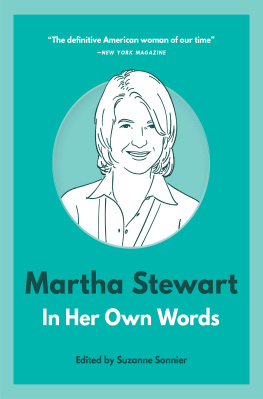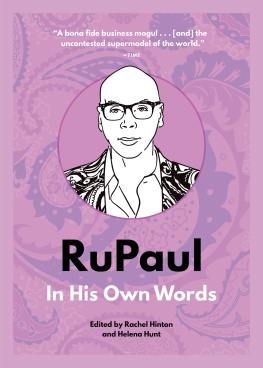
Martha
Stewart
In Her Own Words
Martha
Stewart
In Her Own Words
EDITED BY
Suzanne Sonnier
A B2 BOOK
AGATE
CHICAGO
Copyright 2020 by Agate Publishing, Inc.
All rights reserved. No part of this book may be reproduced or transmitted in any form or by any means, electronic or mechanical, including photocopying, recording, or by any information storage and retrieval system, without express written permission from the publisher.
Martha Stewart: In Her Own Words is in no way authorized, prepared, approved, or endorsed by Martha Stewart and is not affiliated with or endorsed by any of her past or present organizations.
Printed in the United States of America
Martha Stewart: In Her Own Words
ISBN 13: 978-1-57284-288-5
ISBN 10: 1-57284-288-1
eISBN 13: 978-1-57284-840-5
eISBN 10: 1-57284-840-5
First printing: August 2020
10 9 8 7 6 5 4 3 2 1 | 20 21 22 23 24 25 |
Agate books are available in bulk at discount prices. For more information, go to agatepublishing.com.
I was serving a desirenot only mine, but every home-makers desire, to elevate that job of homemaker. It was floundering, I think. And we all wanted to escape it, to get out of the house, get that high-paying job and pay somebody else to do everything that we didnt think was really worthy of our attention. And all of a sudden I realized it was terribly worthy of our attention.
THE NEW YORKER, FEBRUARY 13, 2000
Contents
Introduction
J ust about everyone has an opinion on Martha Stewart, Americas best-known expert on homemaking and entertaining. These opinions can be remarkably strong and polarized relative to her wholesome aim of bringing good things to peoples lives. Whatever one thinks of her, Stewarts arc of stratospheric rise, precipitous fall, and remarkable comeback is as American as a slice of her homemade pie.
Little about her ordinary upbringing suggests that great success would be in her future. Stewart was born to Polish-Catholic, working-class parents in 1941, the second of six children raised in a modest neighborhood in New Jersey. Growing up, she learned gardening lessons from her father and homemaking skills from her mother. By some accounts, her father was demanding and encouraged his daughters perfectionist tendencies in all things.
Intelligent and hardworking, Stewart excelled in school. When she was curious about something, she learned all she could until she became proficient. This would become a hallmark of her life and career.
Her enterprise and good looks led to modeling jobs while still in high school, which continued through college at Barnard and into the early years of her marriage. Then, after her father-in-law taught her about the stock market, Stewart became a licensed broker and worked on Wall Street.
After moving with her husband and baby daughter to a historic Connecticut farmhouse, Turkey Hill, in the early 1970s, Stewart threw herself into cooking from scratch and renovating the house and grounds. Eventually she quit her Wall Street job altogether to run a catering business from her home kitchen.
Catering in her prosperous Connecticut community led to connections and a publishing deal. Her book Entertaining, published in 1982, became a bestseller and launched a media empire. Stewart described the areas of her expertise as living, which included but was not limited to cooking, baking, entertaining, decorating, gardening, crafting, and homemakingall treated with her trademark elegance. She soon became known as a master of the domestic arts. As Stewart put it, I was trying to make a business out of lifestyle. No one had ever done that before. So I was a pioneer in trying to make lifestyle an actual business. And I think I succeeded rather well. By any metric, Stewart is correct.
Her success was built on her image as a polished and patient mentor who could make routine tasks into interesting, even glamorous endeavors. She did this first through her books, and then via television, a magazine, radio, social media, design, and product licensing. As the go-to expert in the profession shed invented, she grew an eponymous empire, employing hundreds of people to expand her brand and support her vision. And she became a cultural phenomenon.
Stewart was more than a lifestyle doyenne, though. She proved to be an exceptionally sharp businessperson as well. In 1997, she had the foresight to buy all of her publishing, television, and retail operations, which she merged to create the company Martha Stewart Living Omnimedia. The initial public offering of MSLO stock two years later made Stewart the first self-made female billionaire in the United States.
She also disrupted stereotypical gender roles. While her subject matter focused on the traditionally female domain of the comforts of home, she was unapologetically competitive and ambitious in business. In combining the two spheres of homemaking and business, Stewart shattered the limits of narrow gender stereotypes.
But not everyone was an admirer. As her public profile grew, critics accused Stewart of being an untrained dilettante, overconfident and didactic. The media mocked her as cold and out of touch. While legions of fans emulated Stewart, a growing chorus of fault-finders ridiculed her.
Ill will toward Stewart reached a crescendo with the ImClone scandal of the early 2000s, in which she was investigated for insider trading, obstruction of justice, and conspiracy related to her sale of 4,000 shares of ImClone Systems stock. Stewart, usually as perfectly composed as her exquisite trays of hors doeuvres, was rattled by the SEC investigation, subsequent trial, public scorn, and made-for-TV movies that resulted. Though she unflaggingly proclaimed her innocence and believed she was unfairly being made an example, she was convicted of lying to the government, obstruction of justice, and conspiracy. She was not convicted of securities fraud; essentially, she was found guilty of a cover-up.
Stewart served a five-month prison term at Alderson Federal Prison Camp in rural West Virginia. The women-only, minimum-security facility was nicknamed Camp Cupcake by the media for its relative luxury, but Stewart found her prison experience horrifying. Home confinement for five months and probation followed her sentence.
Once past the nadir, her comeback was swift. Having lost her Emmy-winning show Martha Stewart Living during her legal troubles, she soon bounced back with a satellite radio channel, a TV talk show, and a spinoff of The Apprentice. Inspired by the frequent advice-seeking of her fellow prison inmates, Stewart wrote a new bestseller, The Martha Rules, on how to start and run a successful business. She resumed making media and licensing deals and writing more bestselling books. She also founded the Martha Stewart Center for Living at Mount Sinai Medical Center, focusing on the health care needs of older adults. In 2015, Stewart sold MSLO to Sequential Brands for $355 million. Sequential sold the business to Marquee Brands, at a steep loss, in 2019. Stewart remains involved with the company.
Today, Stewart is not only back, she is everywhere. Fans can find her on magazine stands, bookstores, radio, retail outlets, and television. Her unlikely TV pairing with rapper Snoop Dogg and stints on celebrity roasts on Comedy Central have boosted Stewarts reputation and yielded an entirely new audience.
Martha Stewarts story is both original and quintessentially American. The self-made business titan took her lumps and emerged victorious, implacable, and ready to resume teaching us all a thing or two.
Next page








